1. Purpose of Research
For some time, it has been said that young people no longer watch TV due to the rise of the Internet. How is TV currently perceived and watched among youth who are "digital natives," or in other words, who have grown up in an environment where new media such as PCs, tablets, smartphones have become widespread? Also, if some youth watch TV even given such circumstances, how can they themselves, their family environment, and relationships with friends be characterized? The Broadcast Committee for Youth Programming (The Youth Committee) of which I am a member, and which operates under the Broadcasting Ethics & Program Improvement Organization (BPO), carried out the "Study on Youths' Media Usage" (BPO Youth Committee, 2018) targeting lower and upper secondary school students and their parents, to achieve the following three purposes.
| Purpose #1: | To provide an overview of the current state of youths' "shift away from TV" based on diaries tracking various media usage. |
| Purpose #2: | To conduct an exploratory analysis on various characteristics of lower and upper secondary school students in relation to TV viewing time (e.g., demographics, psychological factors, home environment factors, and relationships with friends). |
| Purpose #3: | To understand youths' opinions on TV programs and sense of broadcasting ethics. |
This article outlines the results for purposes #1 and #2. For detailed research results, please refer to the full report (https://www.bpo.gr.jp/?p=9470, in Japanese).
2. Research Overview
We conducted a survey research targeting households across Japan with children in the six grades between first grade of lower secondary school and third grade of upper secondary school, and asked the youth and one parent to fill in respective self-administered questionnaires. The research was conducted in 50 locations nationwide, by extracting 2,000 youths (40 youths per location) based on a stratified two-stage random sampling method using the basic resident register (i.e., a national registry of Japanese citizens). The research period spanned from September to November 2017, and surveys were sent out and collected via postal mail.
The survey consisted of three parts: a questionnaires to be filled in by the youth, a questionnaires to be filled in by the parent, and a diary to be filled in by the youth for tracking how long one watched TV programs or listened to radio programs via TV, radio, PC, tablet, or mobile phone/smartphone during 24 hours (for one school day and one non-school day). We obtained responses from 517 households (response rate of 25.85%), while the number of survey responses obtained from youths was 512, the average age of youths who responded (hereafter referred to as "youth respondents") was 14.91 (between 12 and 18 years old), and their gender breakdown was 257 males (50.2%) and 255 females (49.8%). Their breakdown by grade is shown in Table 1.
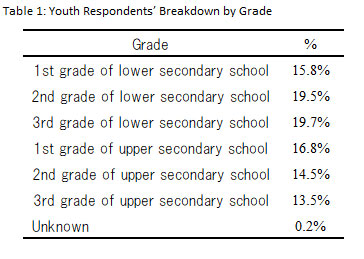
(The number of valid responses was 511. Those attending secondary school, which is a school combining lower and upper secondary schools, were classified into grades equivalent to those of lower and upper secondary schools.)
Tables 2 and 3 show the place of residence of the youth respondents. While the largest portion, accounting for some 30%, lived in the Kanto region, the rest were spread out across Japan with some 10% each living in respective regions between Hokkaido and Okinawa. As for city size, the largest portion lived in cities with a population of 100 thousand or more, accounting for over 40% of all youth respondents.
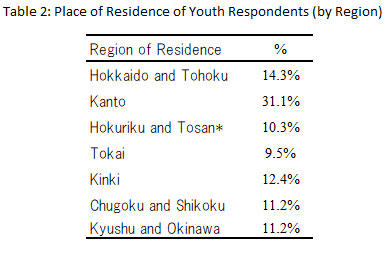
* Tosan region includes the three prefectures of Yamanashi, Nagano and Gifu

* Large city: government-designated cities with a population of 500 thousand or more, and Tokyo's 23 wards.
Parents' surveys were mostly filled in by the mother (82.3%), and respondents' average age was 46.26 years old (between 29 and 69 years old). While the response rate was low, we did not observe a large bias in respondents' attribute distribution, and believe that a certain degree of representativeness in attributes was ensured.
3. Key Results
(1) Youths' TV Viewing Time
We asked youth respondents to keep a diary on how much time they spent using TVs, radios, mobile phones/smartphones, PCs and tablets during the 24 hours of one school day and one non-school day. The percentage of those who did not watch linear TV was 25.6% on a school day and 31.4% on a non-school day (Figures 1 and 2).
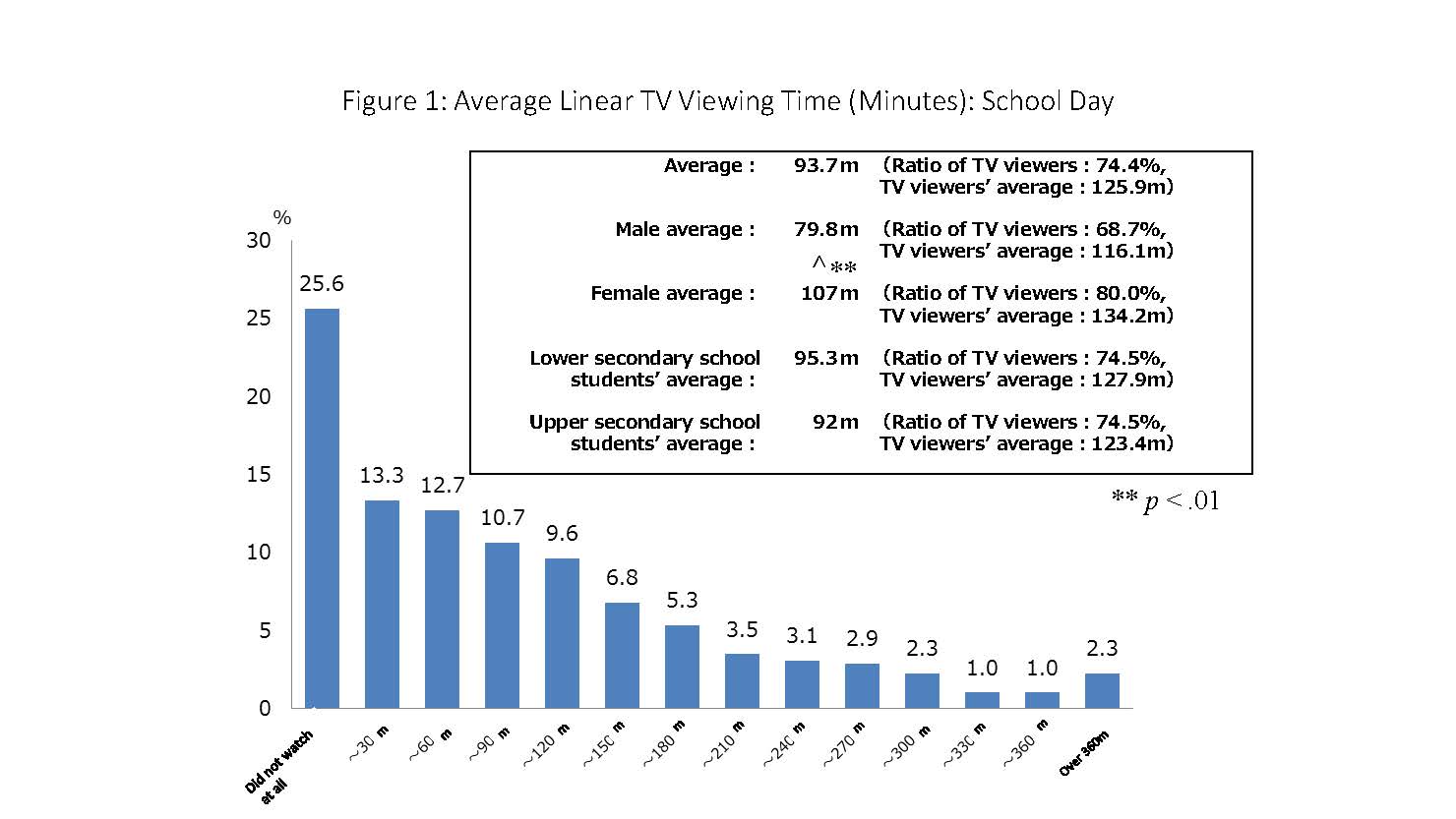
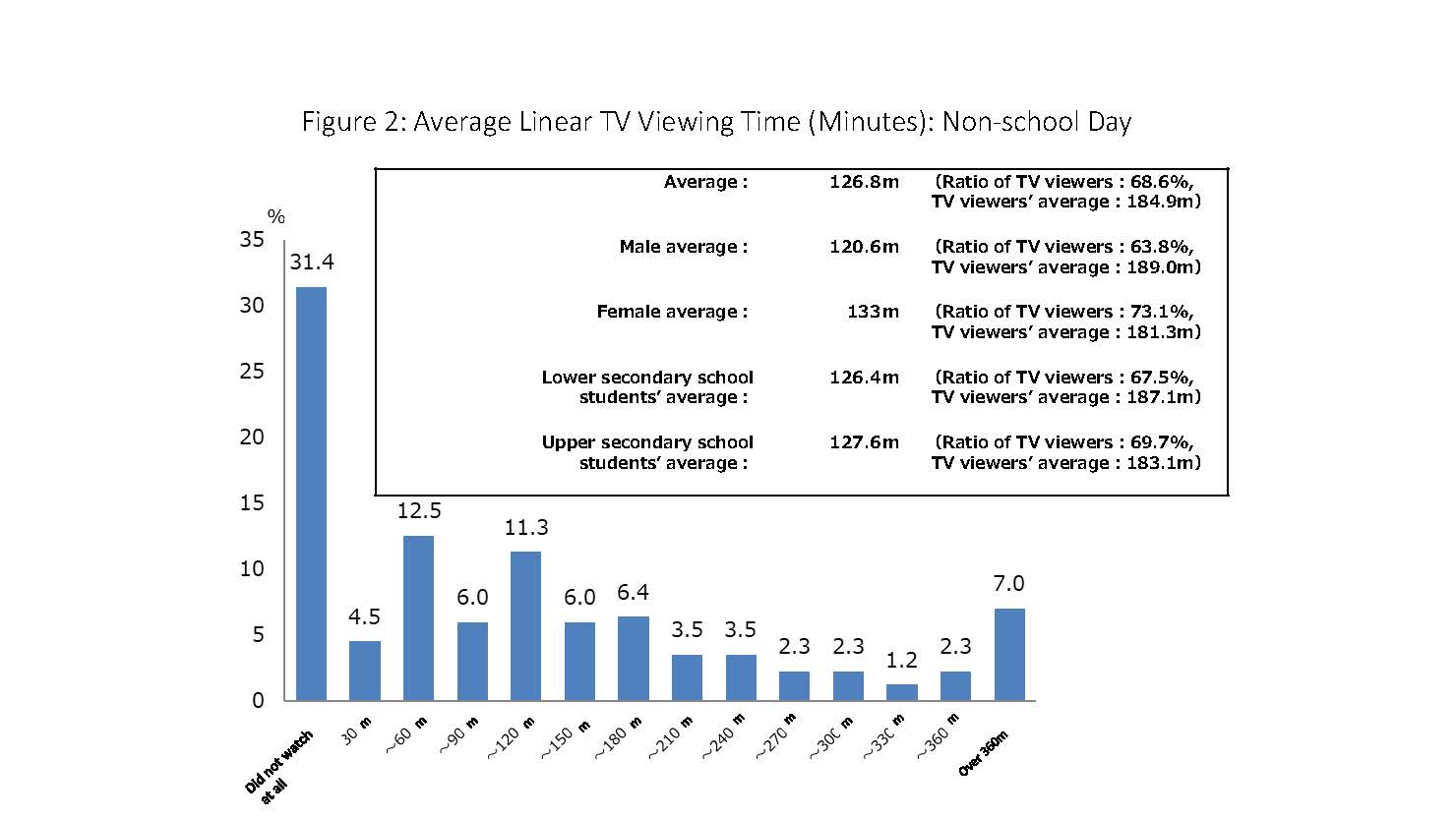
While 13.4% did not watch either linear or recorded/on-demand TV on either a school day or non-school day, it will be necessary to conduct a longer-term diary analysis to clarify whether such youths do not watch TV on other days of the week either and are truly "shifting away from TV." Meanwhile, the average TV viewing time of those "who watched linear TV," accounting for some 70% of all respondents, was relatively long, reaching two hours or more on a school day and three hours or more on a non-school day. Although the difference in TV viewing time between lower and upper secondary school students was not large, TV viewing time among females was 27.6 minutes longer than males on a school day, showing a statistically significant difference (79.8 minutes for males; 107.4 minutes for females; p < .01). The results suggested a potential polarization between the majority who watched TV for a rather long time, and the minority who hardly watched at all. Going forward, it will be necessary to track whether the strata that does not watch TV grows.
(2) Factors Related to TV Viewing Time
An analysis (multiple regression analysis) on factors related to TV viewing time on school days revealed that the following factors were relevant: gender (females), city size (large cities), household income (low), personality (is flexible toward matters and strongly interested in experiencing new matters), shortness of activity time outside home such as club activities and juku (i.e., private supplementary tutoring classes), feeling that watching TV is beneficial, and frequent sharing of TV contents with friends or parents (see Figure 3). Various factors seem to be affecting TV viewing time on school days, when youths attend school and spend a limited time at home while awake.
As for non-school days, results showed that TV viewing time was affected by whether youths stayed at home, and whether there was someone to share TV contents with (i.e., watch TV programs with parents, or talk about TV contents with friends) (Figure 4). No relation was detected with the time spent using smartphones or mobile phones on either a school day or non-school day.
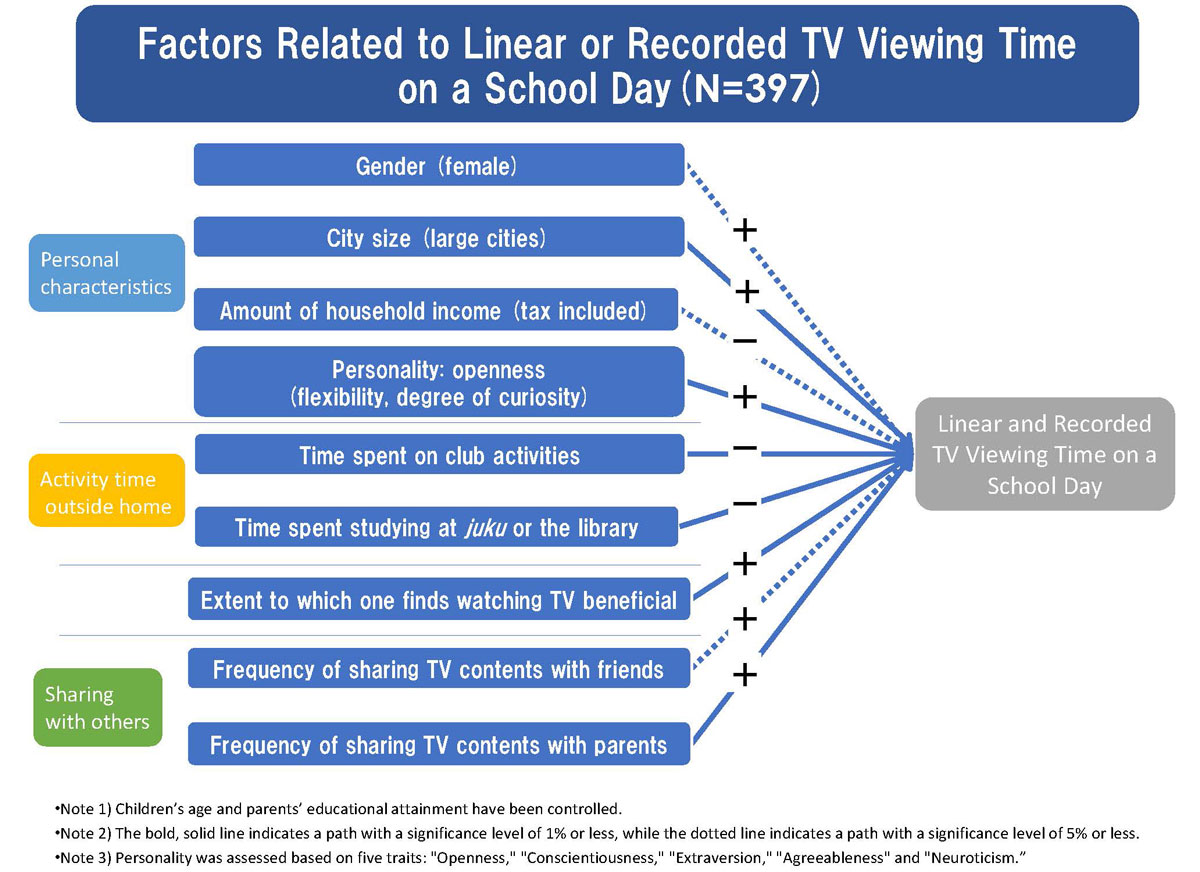
Only includes statistically significant factors based on the multiple regression analysis.
(For details, please see Table 46 on p.61 of the report; https://www.bpo.gr.jp/?p=9470, in Japanese).
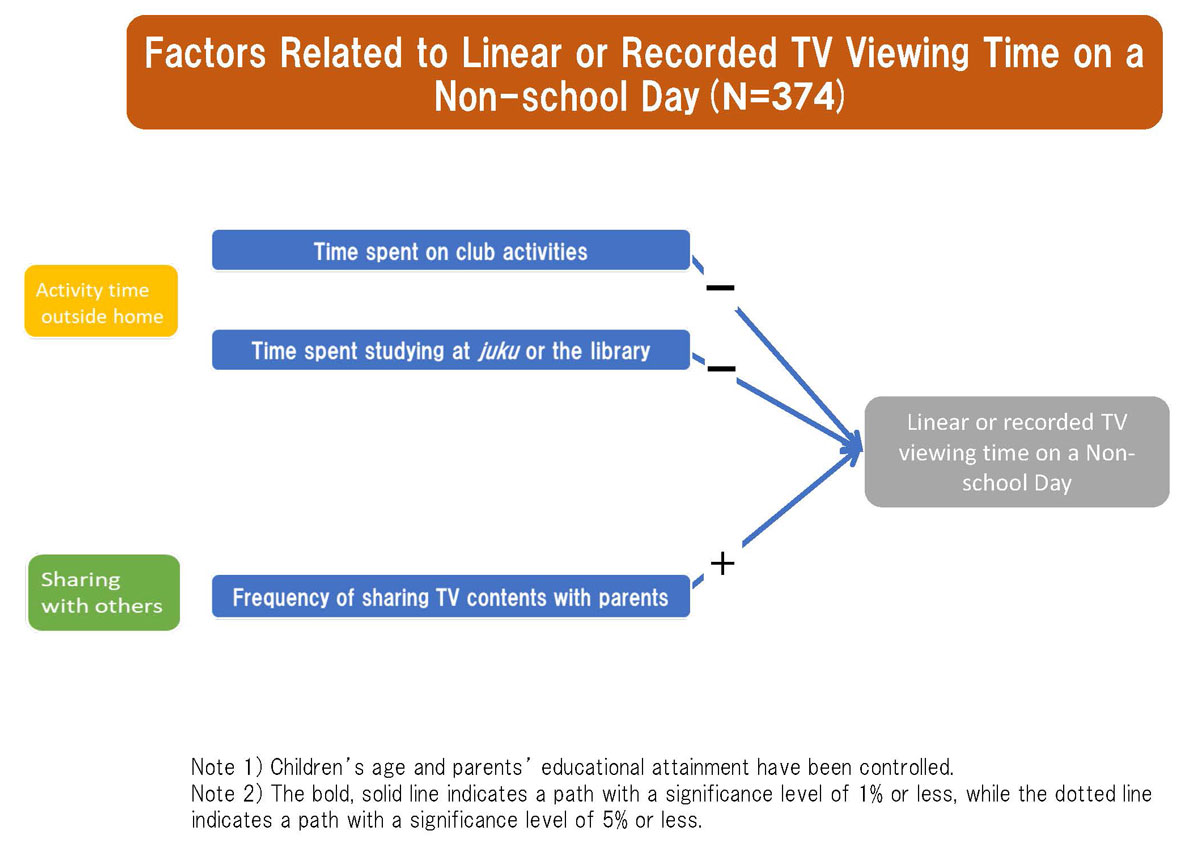
Only includes statistically significant factors based on the multiple regression analysis. (For details, please see Table 47 on p.62 of the report; https://www.bpo.gr.jp/?p=9470, in Japanese).
Results revealed that the shortness of activity time outside home, and the high frequency of sharing TV contents with parents (mothers) were the main effects on TV viewing time (i.e., the effects of these factors were not offset even when considering the effect of all other factors subject to the analysis) for both a school day and non-school day. Regardless of the amount of time spent at home, it was suggested that the time youth respondents spent watching TV was influenced by whether they shared and enjoyed TV programs with their parents. This might be related to parents' preference for TV and good parent-child relationships. More in-depth analysis would be possible by assessing such factors, and examining the details including what kind of programs they watch together and what kind of conversations take place. Also, while we could only survey a single parent (mostly the mother) due to research restrictions, it would be desirable to extend the target to entire households including fathers, grandparents and siblings.
(3) Sharing TV Contents with Family
As revealed in the multiple regression analysis described in Section (2), sharing TV contents with parents was a factor with relatively strong relevance to youths' TV viewing time. Adolescence or the youth period is a turbulent and unstable period when individuals seek psychological independence and become strongly assertive or hostile, and conjures a strong image of individuals valuing their own privacy even at home and distancing themselves from their parents. One might expect that new media such as smartphones, PCs and tablets have led youth to spend more time alone watching programs they want to, and less time watching TV with their parents.
However, when asked how often they watched TV with their family, 60.6% of the youth respondents replied "almost all the time" or "most of the time." The sum of those that selected a frequency of "about half the time" or more was 83.6%, revealing a high ratio (Table 4). According to the diaries on TV viewing time for one school day and one non-school day, the ratio of average TV viewing time with parents or other family members to average total TV viewing time was 71.9% for linear TV and 47.6% for recorded or on-demand TV on a school day, and 64.9% for linear TV and 42.6% for recorded or on-demand TV on a non-school day. In other words, while the majority of those watching recorded or on-demand TV watched alone, a considerably high ratio of 60% to 70% of those who watched linear TV watched with their family. As for parents' surveys, 93.4% responded that they "always" or "sometimes" "watch TV with one's child and laugh together," suggesting that many households with lower and upper secondary school students watch TV together with TV serving to facilitate communication within the family. Also, the fact that 70% or more selected "programs that the entire family can enjoy" as "programs one actively wants to watch," suggests that currently, Japanese families with lower or upper secondary school students have a strong propensity for watching TV together.
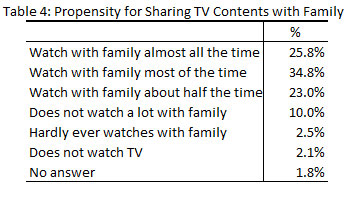
By analyzing the relation between sharing TV contents with family and satisfaction in daily life of youth respondents (based on seven categories including "enjoys every day" and "is satisfied with one's daily life") (Figure 5), the group that shared TV contents with their family had a significant tendency to be more satisfied with their daily life compared to the group that did not. While one can assume that parents must be delighted to be able to enjoy watching TV with their children even during their adolescence and youthperiod, there also seems to be a positive meaning for children themselves. The high degree of sharing TV contents with family may result from the physical factor of "one large-screen TV per family" becoming widespread, and one can assume that sharing a large-screen TV in the living room stimulates communication within the family, which in turn further motivates youth to "want to watch TV with one's family." Longitudinal study will be necessary to reveal the causality of family relationships during adolescence and youth phase, and communication mediated by TV.
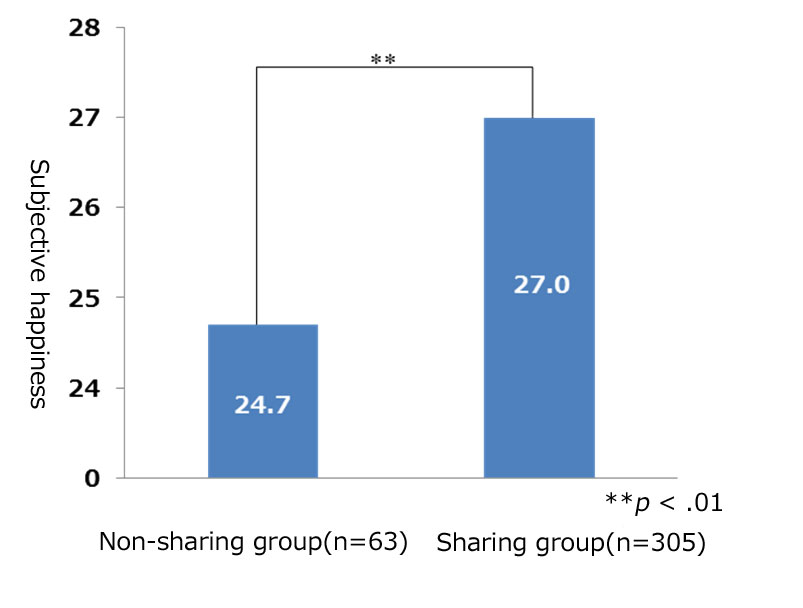
As the Internet advances at an accelerating speed, it will be necessary to elaborate on how TV as a media and TV programs produced by broadcasters are watched by youths going forward, and how such programs would affect their daily lives, and physical and mental development, together with the influence of smartphones and other media.
* This is a joint study conducted with Satoko Matsumoto (Specially Appointed Associate Fellow, Institute for Education and Human Development, Ochanomizu University), Fumiko Inomata (Academic Assistant, Institute for Education and Human Development, Ochanomizu University) and the Youth Committee of Broadcasting Ethics & Program Improvement Organization (BPO Youth Committee, "Cross-Sectional Study on Factors Related to Youths' Actions and Perceptions Concerning TV and Radio," Research Report 2018, https://www.bpo.gr.jp/?p=9470, in Japanese).



 Masumi Sugawara
Masumi Sugawara










